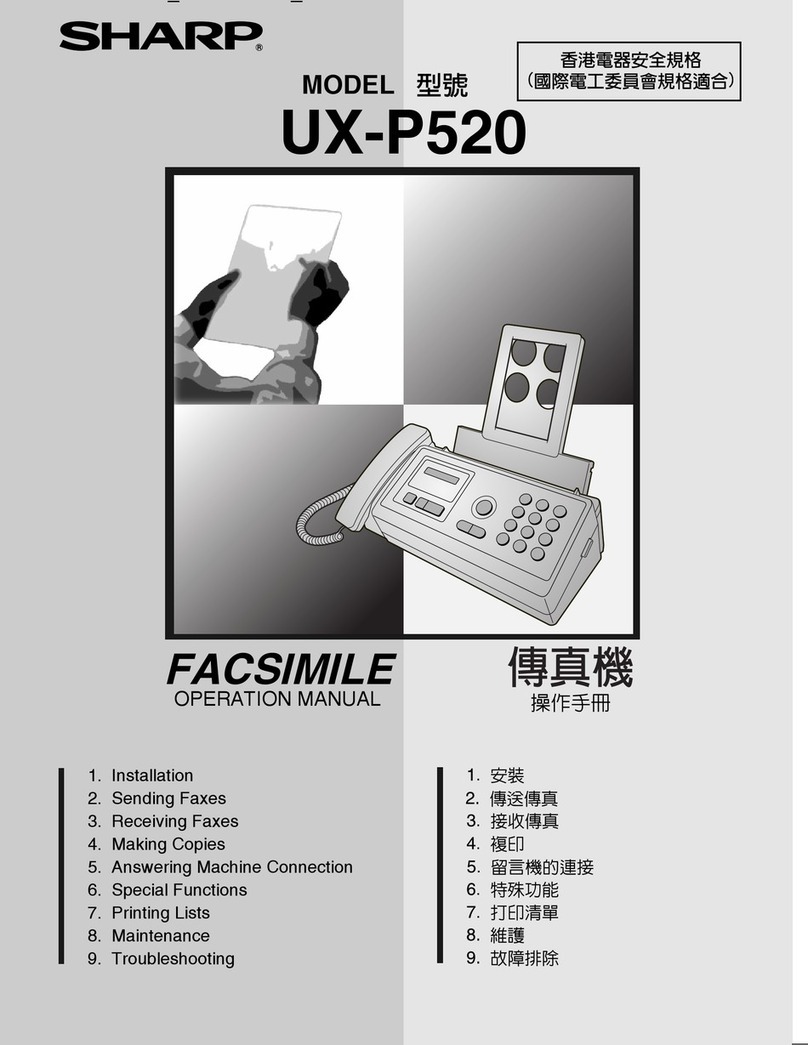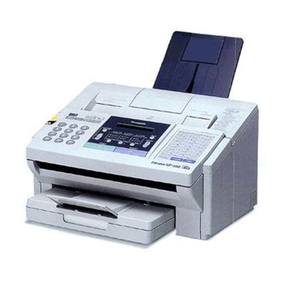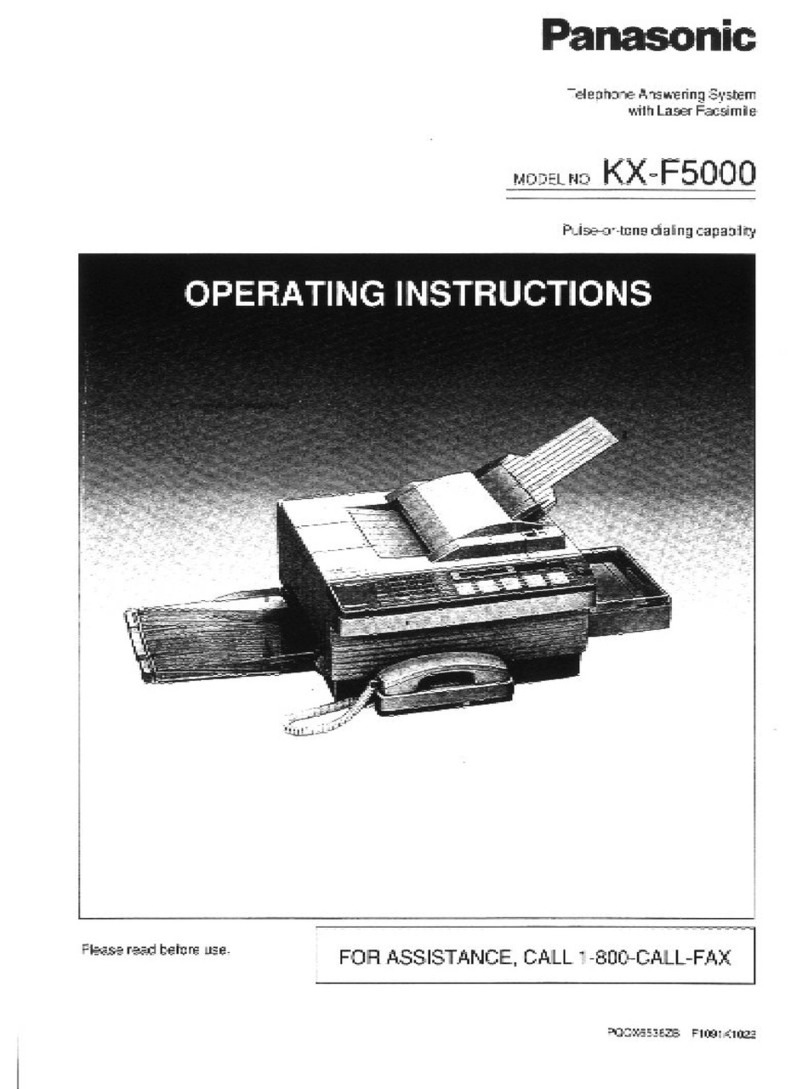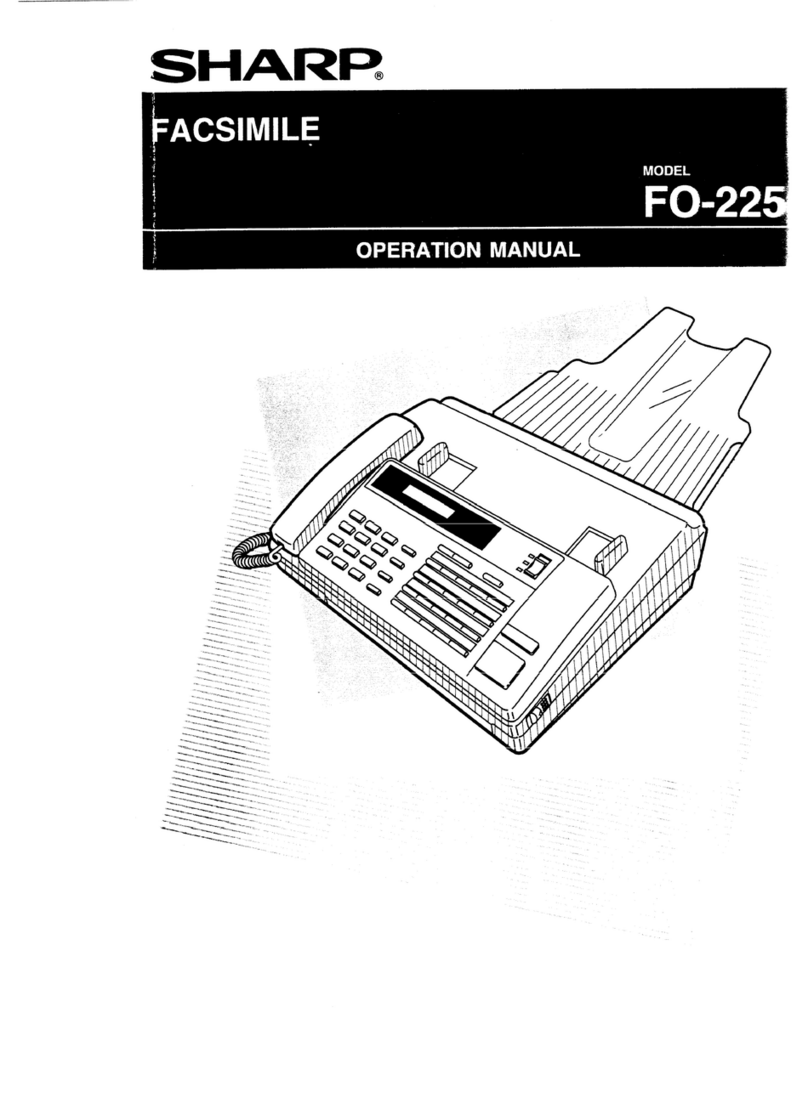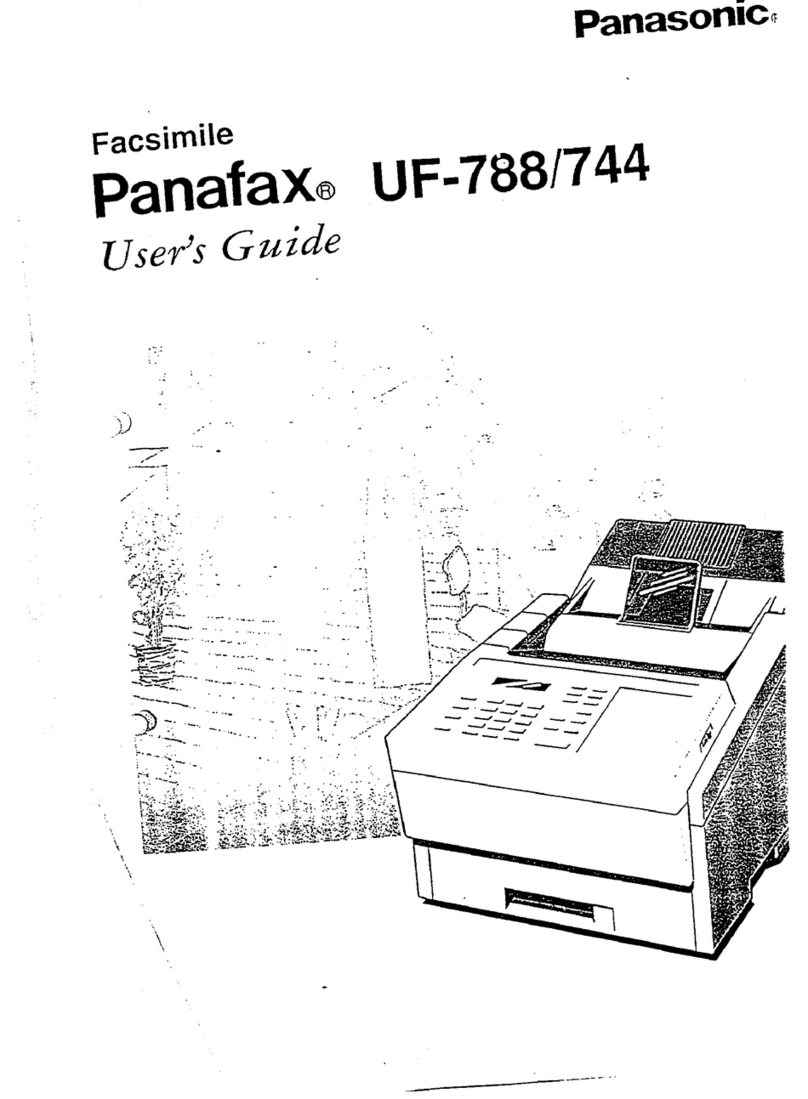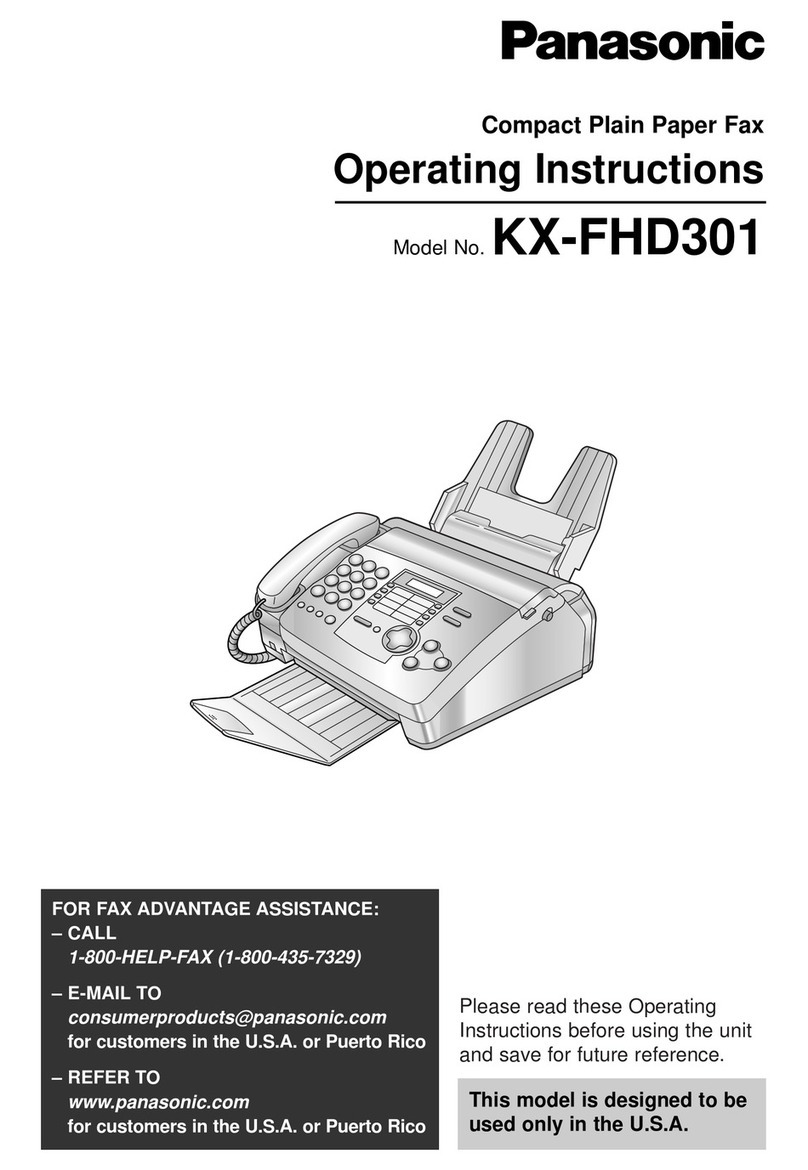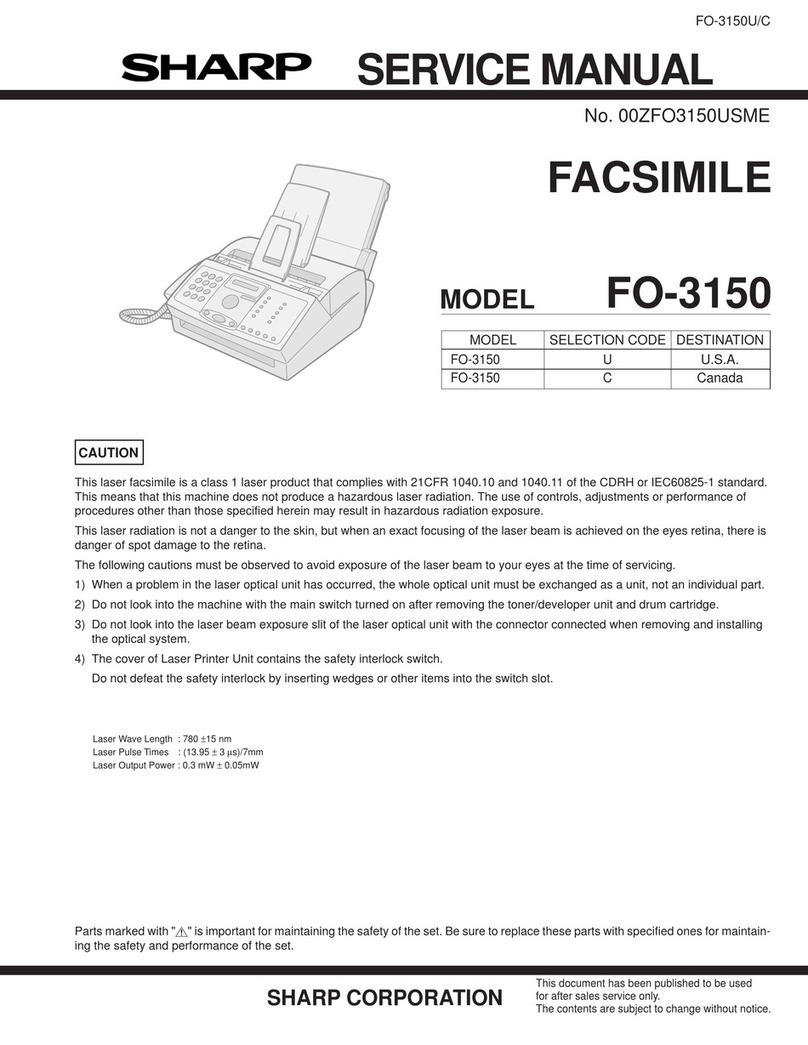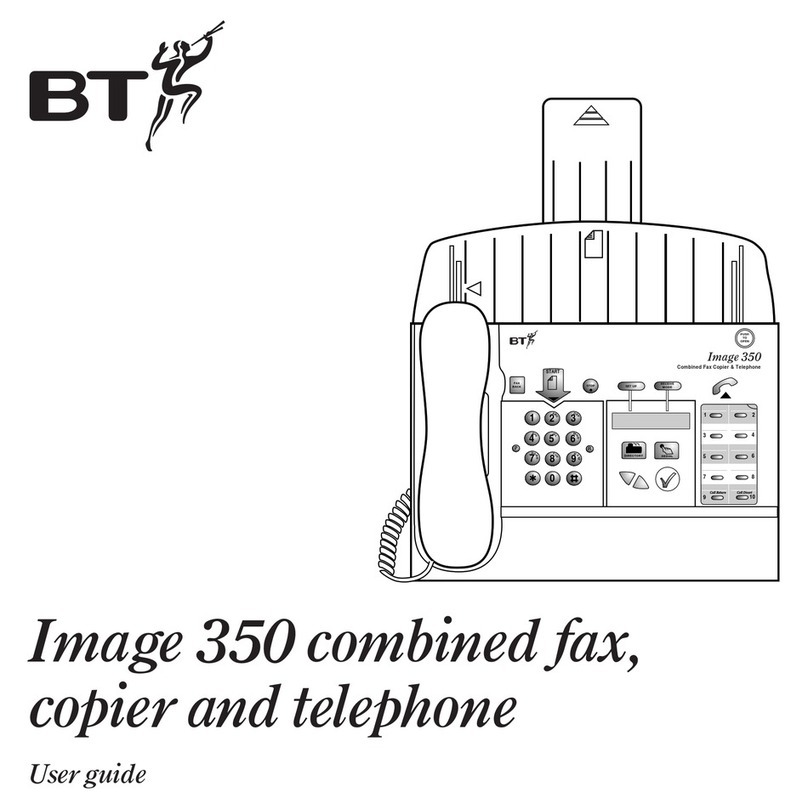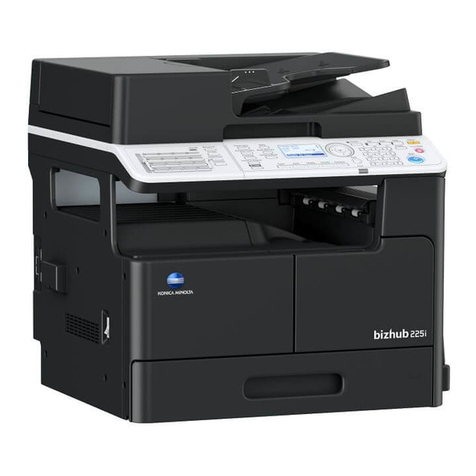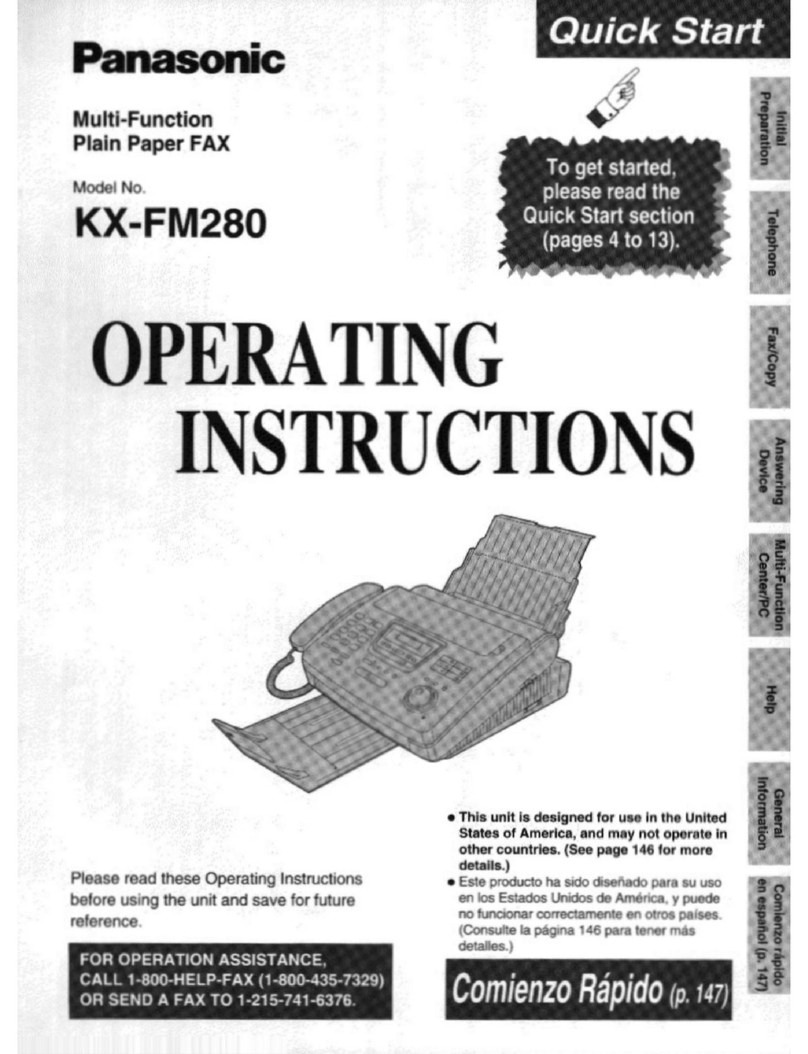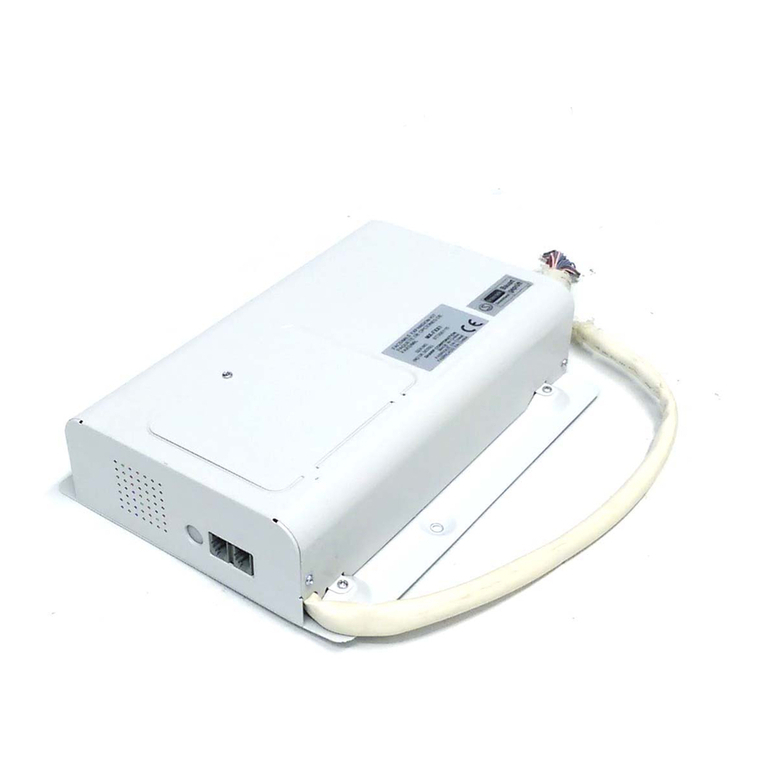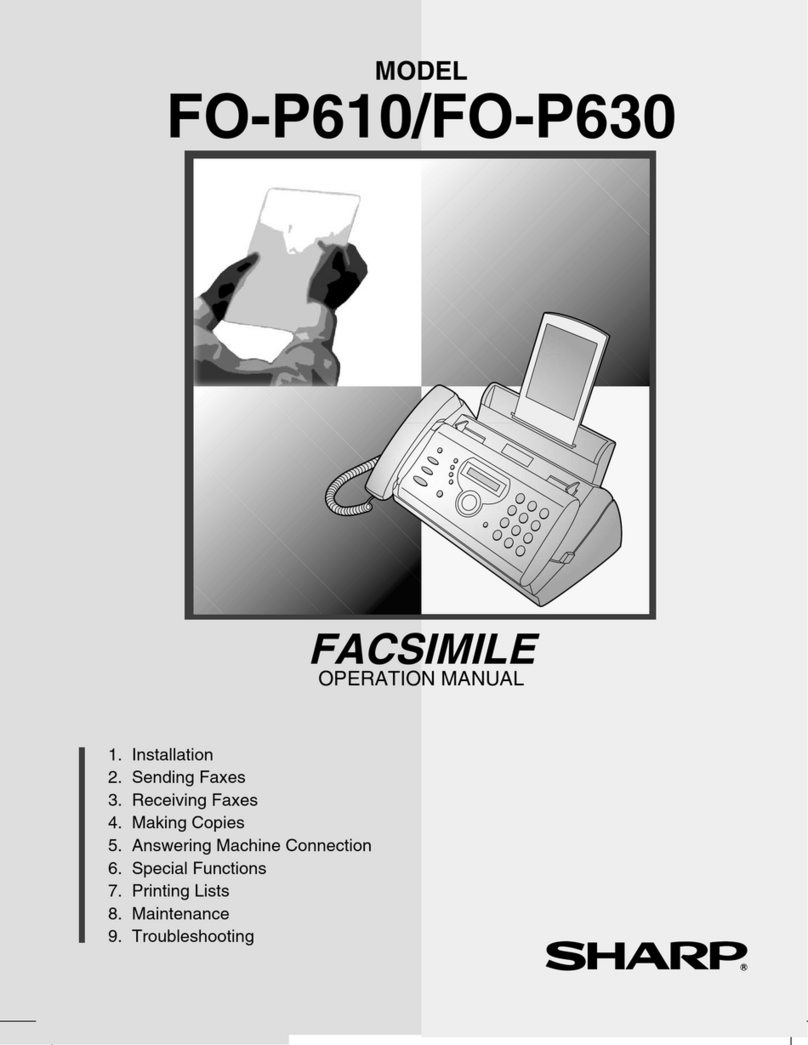TAS Telereader FXR-550 User manual

TELEREADEH
RADIO
FAX
SYSTEM
MODEL
FXH-550
INSTRUCTION
MANUAL
TASCO
ELECTRONIC
C0.,
Ltd

FOREWORD
The
TBLBRELDER
FIRPSSO
you
have
purchased
is
a
computer-
controlled
radio
facsimile
system
developed
by
us
as
the
first
in
the
industry.
It
has
been
designed
and
manufactured
by
our
specialized
technologies
in
digital
and
analogue
signal
processing
and
computer
control,
which
have
been
developed
since
we
began
marketing
the
TELEREADER.
Read
through
this
manual
to
enjoy
the
TELEREADER's
performance
to
the
maximum
for
a
long
service
life.
CONTENTS
1.
Features
of
FIRPSSG
..................................
1
2.
Specifications
.......................................
2
3‘
IIIFIIIlll-I'll-Illlllllil-IllilllIliliillil-ll-llI-I-I
I}
4.
Front
panel
controls
.................................
6
5.
Operation
of
front
panel
controls
....................
7
6.
Rear
panel
connections
...............................
11
7.
Operation
of
printer
.................................
11
8.
Reception
of
business
facsimile
information...........
15
9.
Reception
of
amateur
facsimile
transmission
..........
18
10.
List
of
frequencies
of
facsimile
stations
in
the
world
19

1.
Features
of
FIR—550
(1)
(2)
(3)
(4)
(5)
(6)
(7)
FIR-550
is
s
computer-controlled
video
information
processing
system
which
processes
facsimile
information
to
get
a
video
display
on
a
monitor
CRT
screen
or
hard
copy
from
a
printer.
Facsimile
information
the
FIR-550
can
process
includes
the
meterological
facsimile
information
transmitted
in
short
wave
band
(ground
weather
map,
radar
weather
map,
forecast
weather
map,
sea
state
map,
sea
ice
map,
synoptic
wave
chart,
etc.)
and
private
transmission
from
amateur
stations.
Either
a
regular
color
or
monochromatic
television
set,
graphic
display
CRT,
television
set
equipped
with
video
terminals
or
ordinary
RGB
monitor
(640
x
200
dots)
of
TTL
level
interface
can
be
used
for
the
display
monitor.
A
printer
can
be
connected
to
get
a
hard
copy.
Drum
speed
can
be
set
automatically
by
the
automatic
synchronization
detector.
Video
signals
from
meterological
satellites
can
be
displayed
or
printed
with
the
gradation
expressed
by
8-tone
display.
(Artificial
color
display
can
be
obtained
on
an
KGB
color
monitor.)
Can
be
used
as
a
test
signal
generator
for
the
adjustment
of
the
video
monitor
or
other
equipment
by
installing
optional
TEST
chips.
Signal
reception
can
be
monitored
by
the
built-in
audio
monitor
at
a
desired
volume.
-
1
-

Specifications
(1)
Applicable
drum
rotation
speed
60, 90,
120,
180,
240
rp
and
AUTO
(In.AUTO
mode,
drum
speed
is
selected
from
among
60
rpm
to
240
rpm.and
set
automatically
on
reception
of
synchronization
signal.)
(2)
Index
of
cooperation
144,
zss,
s22,
sve
(3)
Video
display
Received
picture
576
x
200
dots
Motion
display
6h
n
200
dots
Total
6&0
x
200
dots
Picture
formation
From
left
to
right
end
Picture
gradation
B
tones
(correspond
to
8
colors)
*
Can
be
switched
to
2-tone
monochromatic
display.
(4)
Input
AF
input:
Input
impedance
1kfl.(Operable
on
89
-
10kQ)
Input
voltage
150
mfl
or
over
(5)
Input
audio
frequency
19DOHas400Hs
White
level
2300Hz
Black
level
150DHz
Phase
synchronization
l5UOHas3Z
or
230DHzt3Z
_
2
-

(6)
(7)
(8)
(9)
10
Output
VIDEO
OUT:
Composite
video
signal
lVp-p
or
over
(arse
system)
Digital
ass
signal
TTL
level,
horizontal
synchronisation
at
l5.75kHs
Printer:
Centronics
parallel
interface
Test
signal:
(In
the
case
of
optional
equipment)
Phase
synchronization
l500Hz
or
2300Hz
White
level
8
tones
from
2300Hz
white
to
black
Black
level
l500Hs
Audio
output
0
dbm
or
over
at
6009
Power
nc13
-
lav,
Std.
13.sv,
s50
me
Dimensions
225
m
(W)
x
170
mm
(D)
a
50
mm
(H)
Weight
Approx.
1.fi
kg
Accessories
Instruction"manual
Earphone
plug
Video
monitor
comunication
cable
AP
input
cable
1A
glass
tube
fuse
...3_
sap?

3.
Hookrup
(1)
Hooking
up
the
power
supply
After
making
sure
that
the
stabilized
power
source
provides
voltage
within
the
range
of
13V
to
14V,
turn
off
the
power
switches
of
the
power
source
and
the
FXR-550.
Connect
the
red
wire
to
the
positive
terminal
and
the
black
wire
to
the
negative
terminal
of
the
power
source.
(2)
Hooking
up
a
video
monitor
For
the
video
monitoring,
either
a
monochromatic
CRT,
graphic
display
or
ordinary
television
set
equipped
with
video
terminals
can
be
used
(monochromatic
display
even
on
a
color
CRT)
Connect
the
VIDE0.0UT
terminal
of
the
FXR-550
and
the
VIDEO
input
terminal
of
the
video
monitor
with
the
attached
television
communication
cable.
HADE
IN
JAPAN
T“V
C)
(D
Y
VIDEO
UUT
CDLUR
(3)
Hooking
up an
RGB
color
display
Connect
the
COLOR
terminal
of
the
FXR-550
and
the
input
terminal
of
the
color
display
with
a
display
cable
of
RGB
B—pin
specification
available
on
the
market.
An
RGB
display
of
digital
RGB
system
with
horizontal
synchronization
frequency
of
15.75kHz
can
be
used.
-4-

While
the
RGB
display
should
generally
be
of
2000
characters
specification,
an
RGB
display
which
can
be
set
for
2000
characters
can
be
used
by
selecting
it.
As
the
basic
display
of
the
FXR-550
is
8-tone
_
monochromatic
picture,
the
tones
are
expressed
by
artificial
color
tones
in
color
display
operation.
Monitoring
by
a
monochromatic
(green)
display
will
give
a
more
natural
impression.
HADE
IH
JAPAN
T“V
Y
O O
VIDEO
UUT
COLOR
Hooking
up
a
receiver
The
FXR-550
forms
pictures
by
processing
audio
signal
fed
from
a
receiver.
Connect
the
AF.IN
terminal
of
the
FXR*550
and
the
headphone
output
terminal
or
the
speaker
terminal
of
the
receiver
with
the
attached
audio
cable.
HAED
IH
JAPAN
_
.RECEIVER
L—“‘t{_
Hooking
up
a
printer
Connect
a
printer
with
Centronics
parallel
interface
through
the
optional
printer
cable
(TR—Kl).
_Because
the
bit
image
functions
differ
with
the
printers,
refer
to
the
paragraph
"Operation
of
printer"
for
the
selection
and
operation
of
a
printer.
-.5_

HADE
IH
JAPAN
PRIFTER
-I
H
.l-I-'—.|-I-__r
.
_|-L
_'_
.._
i
Q.
Front
panel
controls
rsiirssaiss
RADIO
FAX
SYSTEH
L
I
__'l-$1-
|
I
iq
5
E
..l
——~‘aI.=1!,5;
5|,
a——-
~
§l500Hr
(15)
snail
|1B
B
9:10’
|
U
¥
mm-1
WI
I
E
~
I
323008:
(15)
P0wERo——
PDHER
1
I
-
i
some
FXR—55U
Fist
(1)
(2)
(3)
(h)
(5)
(6)
(7)
POWER
MDNI
r.p.m.
M
SYNC
GRADE
TEST
(8)
HOME
(9)
PUG/NEG
Power
switch
Volume
control
for
audio
monitor
Drum.rotation
speed
selector
Selector
for
index
of
cooperation
Synchronization
selector
Tone
selector-a
Test
signal
generator
(In
case
the
optional
TEST
chips
are
mounted.)
To
move
the
starting
point
of
raster
scan
to
the
initially
set
position.
Black/white
inversion
of
display
and
hard
copy
-6-

(10)
(11)
(12)
(13)
(14)
(15)
(16)
(17)
(18)
(19)
PRINTER
START
PAUSE
UP
DWH
l5UOHs
2300Hz
SYNC
POWER
ON/OFF
selector
for
printer
Manual
start
of
reception
Temporary
hold
of
display
screen
(Printing
out
in
eight
tones
can
be
obtained
only
during
temporary
hold.)
Upward
shift
of
the
screen
(for
the
correction
of
phase
bar
position)
Downward
shift
of
the
screen
(for
the
correction
of
phase
bar
position)
10-segment
LED
bar
for
receiver
tuning
indication
'
10-segment
LED
bar
for
receiver
tuning
indication
LED
indicator
for
phase
synchronization
tuning
Power
indication
LED
5.
Operation
of
front
panel
controls
ri
CRI
display
I“
I
1'11
13.
Idisplay
display
T
Name
II
.t.
1
I
ch
I‘
f
.
Operation
ange
o
i
"id
—._
__.."l
“i
l
|
r.p.m.
???r.p.m.
'???-+60rpm
iln
the
drum
rotation
speed
—>90rpm—+
idisplay
in
AUTO
mode,
the
drum
-*l20rpm.
=rotation
speed
is
automatically
—*13Urpm—+
set.
—*240rpm.
?If
the
drum
speed
is
known
when
synchronization
is
attained,
drum
speed
should
be
set
imanually.
In
manual
setting,
ithe
drum
speed
is
changed
from
60
rpm
through
240
rpm
sequentially.
—
*
l
I
_'
H
in
_il
im
-7-

@
CRT
display
F
._'__
-'.__
—i
—i
—
D
-1
—'
ii".
i—
I
D
_
ii“;
_i
_il
_l
I
|
Ii
"'_—
"JR
;__
1’-"
__I
i
Initial
F
Change
of
l
display
5
display
I
Name
Operation
'|
L_
—"
j_
_|
—i
-
—
“K
'
I
1
s
i
576
D
57s—+422-+
i
*
2ss—*1a4
|
I
1
.‘
|
I
_E
H
I
—i.
in
I
.
1'
1
‘._l
_—
!In
the
display
of
the
index
of
cooperation,
index
of
Fcooperation
is
changed
sequentially
starting
with
576.
;5?6:
4
lines
i
signals
line.
422!
3
lines
of
received
are
displayed
in
1
i
of
received
1
i
signals
are
displayed
in
I
line.
288:
2
lines
signals
line.
of
received
are
displayed
in
1
;1aa=
1
line
of
received
signal
is
displayed
in
l
line.
(In
the
case
of
120
rpm.)
J
|
I
_¥ I
1
1-'_._
..
SYNC
2300Hz
|
23DOHa"*
'
l
l5UOHs
i’
I
-
1
_-_-|
I|—-r'
.1
1
—n|—.___Z—-
__n
|
ifielection
of
white
synchronisa-
tion
and
black
synchronization.
|
—
pi
_i
ii
1
Ii
1
_
1.
_
Z
'
_
"-r
1
iii!
-I
It
I.
—
-.—|
_GRADE
l
EIIIIIII]
White
Black
White
Gray
Black
1:11:11:
hhite
ck
Bla
..|
|
‘Select
8—tone
or
2-tone
display
sin
the
tone
selection
display.
When
2-tone
display
is
selected,
gradation
can
be
adjusted
by
threshold
setting.
yadjust
it
so
that
clearest
contrast
of
black
and
white
is
obtained.
Gradation
of
the
chard
copy
is
changed
at
the
same
time.
1
_
_|
_
1-
_fl
I-IIIII
1
_l—$
I‘?
i-IIIII
TEST
I
I
__-1'?‘
-
l
rssr
l
I
"I
F
|
|
F.
|
_______L
_
__
-
Iiiij
—
-
‘Effective
only
when
optional
chips
are
installed.
Stored
test
data
are
displayed
on
the
screen
at
the
specified
rpm
(M)
with
SCFM
output
issued
on
the
ITEST
terminal
at
the
same
time.
-
__
_
_
---
-
-H
—
—_—|
I-'
In
l
1
J
%
F
i
1
|
-L
....B_

J
II__L
HOME
§
I
Q
i
|
l
i
_
i]
_
3
—
_
1
.
—
I
i
-
CRT
display
I
Name
Ilnitial
5
Change
of
Idisplay
display
,
Operation
i
—
ii“
—.'i."I
_
I'll
—_
H
|
I
I
I .
8
I-L.
_
'
_'
|--
i
—-
Have
the
picture
displayed
.
starting
at
the
bottom
left
(HOME
position)
in
the
cource
of
reception
I
I‘
E
.'.
'
F
i
i
:
y
POG/NEG
soc
c
PUG-+NEG
i
1
|
iii
I
__
‘I
i
I
I
I
“'
’
I
'
:__
"i
H
1
—
_.
i
I
_'
_
To
inverse
the
black
and
white
of
the
picture
on
the
display
and
hard
copy
during
or
after
reception
l
I‘
;
PRINTER
PRINTER
I
__
_
_|
I
_
_‘
—
When
this
is
turned
on,
hard
copy
in
two
tones
can
be
printed
out
during
reception.
To
print
hard
copy
in
eight
tones,
turn
on
the
PRINTER
after
holding
the
screen
by
PAUSE.
*
If
PAUSE
is
pressed
during
simultaneous
printing
while
receiving,
printing
is
automatically
turned
off.
I
|
I‘
|
I
START
AUTO
_I
MANU
'
I"
|
F“
.
Display
is
started
automatically
if
synchronization
is
confirmed
for
a
certain
period
in
AUTO
mode.
In
MANUAL
mode,
display
is
started
regardless
of
the
synchronization
input.
If
interrupted
by
PAUSE,
the
mode
is
changed
to
AUTO.
_
m
1.
"Hi;
.
_
I
.
'_i—
Ii
PAUSE
,--*-r-"-
PAUSE
l
._
_-
_§
To
hold
the
reception
screen
temporarily.
When
this
is
effected,
simultaneous
printing
(2-tone)
is
stopped.
-
By
pressing
PRINTER
again,
8-
tone
hard
copy
can
be
obtained
By
pressing
the
PAUSE
button
again,
raster
scan
is
started
at
the
position.
9-

23DOHz
150DHz
ID-
segment
LED
,
CRT
display
“~‘-“"=
,
Initial
Change
of
°P“““i““
*disp1ay
display
UP
E
----
-----
To
shift
the
phase
bar
upward
when
reception
is
started
with
the
SYNC
signal
out
of
phase.
Shifting
is
repeated
line
by
line
while
the
button
is
being
pressed.
sq
L
_
..,
_
i
----r
-—-*---
To
shift
down
the
phase
bar
1
when
reception
is
started
with
the
SYNC
signal
out
of
phase.
A
I
'
H.'“_____i
“
‘j
I
Z
l
at-i.
A
l
D
1
i
I
To
tune
the
receiver
so
that
the
two
bars
indicate
the
,
maximum.
23UOHz
15005:
SYNC
POHER
Blue
LED
Synchronize
tuning
LED
for
23ODHz
and
15UDHs;
Tune
the
receiver
so
that
SYNC
blinks
periodically
on
the
display.
Comes
on
when
power
is
supplied.
-.10-

fi.
Rear
panel
connections
HADE
IH
JAPAN
EIT
UUT
13-14?
'7'
C) C)
I
-
-
~
-
~
I
C)
{D
C)
C)
VIDEO
OUT
COLOR
-
=
TEST
OUT
AF
IH
I
13
PRINTER
1
(BI
fl)
(5) (5)
(4
(3
(3
(1)
(1)
Red/black
cord:
1-
For
the
connection
of
stabilized
power
source
of
D013
—
let,
1A
or
over
(2)
AF.IN:
Input
terminal
for
audio
signal
(3)
EXT.OUT:
Output
terminal
for
external
speaker
(connected
with
AF.IN
internally)
(4)
TEST.OUT:
Output
terminal
for
TEST
signal
(Delivers
SCFH
signal
of
test
screen
by
installing
optional
chips.)
(5)
PRINTER:
Output
terminal
for
printer
(6)
COLOR:
Output
terminal
for
RGB
color
monitor
(?)
VIDEO
OUT:
Output
terminal
for
video
monitor
(B)
EARTH:
Grounding
terminal
?.
Operation
of
printer
Because
the
FER-550
delivers
printer
output
of
bit
image
picture,
the
printer
must
be
equipped
with
bit
image
function.
Since
the
operating
conditions
of
printers
vary
with
the
models
and
the
makers,
the
FXR-550
is
provided
with
printer
selection
function
to
enable
several
types
of
printers
to
be
used.
Note
that
the
picture
resolution
varies
depending
on
the
printer.
-11-.-

Connecting
the
printer
Connect
the
printer
to
the
printer
output
terminal
of
the
FXR—55O
which
delivers
Centronics
compatible
output
signals,
with
the
optional
printer
cable.
2-tone
printing
2-tone
printing
can
be
obtained
concurrently
during
signal
reception.
Note
that
the
speed
of
simultaneous
printing
may
be
slow
depending
on
the
printer,
and
may
not
be
done
normally
if
the
drum
rotation
speed
is
high,
Desired
gradation
of
the
hard
copy
can
be
obtained
by
adjusting
the
threshold
in
2-tone
display
mode.
B-tone
printing
B-tone
printing
cannot
be
done
unless
the
screen
is
held
still
with
the
PAUSE
button.
Time
taken
in
printing
and
the
resolution
of
the
picture
vary
depending
on
the
printer.
Printer
selector
Printer
selector
is
provided
at
the
front
center
of
the
bottom
which
is
to
be
adjusted
with
a
flat
tip
screw
driver.
Bottom
of
the
case
Front
panel
-12-

Applicable
printer
EPSUH
SP-BBPC
EPSON
VP-BUPC
EPSUH
VP—130PC
SEIKUSHA
GP—5UOH
22
SEIKOSHA
SP-SDOEE
SEIKBSHA
F4
UT
A
OJ
SP-B00
Remarks
S
E
m
i
—
_
—
_
—
:
I
fi
!
#
.
H81
printer
Operation
may
be
unstable
when
the
index
of
coopera-
tion
is
lbs.
-
13
_
i
I-|-uljj-|-pi

I‘
17
_I.L_I
E3
I
._i-.i_.
Q
I
ET
,..
.l_r
_
___.___.__________,
_
_
:
_
I
'
I
1-I
—
I
I
F
l
Fm
1
I
31-
I
I
|_'
I
r
—
-
I
(Caution)
1)
2)
3)
4)
5)
Printers
other
than
those
listed
above
can
also
be
used
if
they
have
the
same
bit
image
mode
as
those
specified.
Hard
copy
of
2-tone
can
be
printed
with
higher
resolution
than
the
CRI
screen,
provided
that
the
resolution
depends
on
the
printer.
The
aspect
ratio
(index
of
cooperation)
of
the
hard
copy
varies
depending
on
the
printer.
Small
letters
and
fine
pictures
can
be
printed
clearer
by
particular
setting
of
the
index
of
cooperation.
Similarity
printing
in
eight-tone
can
be
done
by
setting
two
times
higher
value
for
the
index
of
cooperation.
_
14
_

B.
Reception
of
‘business
facsimile
information
(1)
Heterological
facsimile
information
Facsimile
information
of
meterological
charts
are
_transmitted
by
a
unified
standard
in
accordance
with
the
HBO
recommendation.
Host
meterological
facsimile
information
in
the
world
is
transmitted
at
120
rpm
with
the
index
of
cooperation
of
576.
Operating
procedure
1)
Set
the
receiver
in
LSB
mode.
2)
Adjust
the
volume
of
the
receiver
to
the
position
about
1/3
of
the
full
volume.
3)
Adjust
the
volume
of
the
audio
monitor
to
the
desired
level
with
the
HOHI
control
of
the
FIR-550
4)
Hake
sure
that
SYNC
is
set
to
23OOHz.
(It
has
been
set
to
23003:
at
the
factory.)
5)
Set
the
tuning
dial
of
the
receiver
at
a
frequency
1.9kHz
higher
than
the
published
frequency.
6)
.Adjust
the
tuning
dial
up
and
down
slowly
to
find
the
position
where
both
LED
bars
of
15003:
and
23OOHz
become
the
longest
and
blink.
7)
Both
LED
bars
may
not
reach
the
maximm
at
the
same
time
depending
on
the
conditions
of
radio
transmission
and
the
transmitted
text.
-15-

3)
Hake
sure
that
SYNC
LED
is
blinking.
After
the
above
procedure
under
good
radio
transmission
condition,
if
reception
is
started
at
the
head
of
the
data
where
only
the
synchronization
signal
is
transmitted,
clear
picture
can
be
obtained
with
the
phase
signal
synchronized
and
the
rotation
speed
automatically
set.
Cautions
If
reception
is
started
amid
the
video
signals
and
much
black
points
are
included
in
the
video
signals,
phase
signal
and
video
signals
cannot
be
discriminated.
1)
When
automatic
setting
of
the
drum
speed
cannot
be
made
or,
if
made,
it
does
not
agree
with
the
received
picture,
set
the
drum
speed
manually
with
the
r.p.m.
button.
2)
When
reception
cannot
be
started
or,
if
started,
phase
bar
is
displayed
on
the
screen,
try
as
follows.
*
If
automatic
start
is
not
effected,
make
a
forced
start
with
the
START
button.
*
Remove
the
phase
bar
out
of
the
screen
across
the
top
or
the
bottom
whichever
the
nearer,
with
the
UP
or
DOWN
button.
3)
To
make
the
start
of
the
transmitted
picture
agree
with
the
start
of
display
screen,
press
the
HOME
button
at
the
start
of
the
reception.
-16-

Adjustment
of
gradation
Among
the
meterological
facsimile
information,
only
the
photograph
of
clouds
by
stationary
meterological
satellites
and
test
charts
are
the
signals
with
gradation
and
the
rest
are
black
and
white
signals.
Although
2-tone
signals
can
be
received
in
3-tone
mode,
fine
lines
may
not
be
clearly
displayed.
To
get
a
clear
display
of
fine
lines,
set
the
2-tone
mode
and
adjust
the
threshold
point
so
that
clearest
display
is
obtained.
If
a
printer
is
used
at
the
same
time,
adjust
the
threshold
position
so
that
the
clearest
hard
copy
can
be
obtained.
Inverted
display
may
be
clearer
depending
on
the
picture.
Try
it
with
the
FOG/NEG
button.
Entire
screen
can
also
be
inverted
by
pausing
the
reception
screen.
Note
that
inverting
the
display
screen
causes
the
printed
picture
to
be
inverted
too.
Enlarged
display
and
hard
copy
While
small
letters
and
fine
lines
can
not
be
displayed
because
of
the
total
number
of
dots,
higher
resolution
can
be
obtained
by
partial
enlargement
with
the
index
of
cooperation
(H)
and
drum
speed
appropriately
selected.
*
Set
the
index
of
cooperation
to
the
half,
and
the
picture
is
expanded
by
two
times
horizontally.
*
Set
the
drum
speed
two
times
higher,
and
the
picture
is
expanded
by
two
times.
_l7'-

*
Part
of
the
picture
to
be
displayed
can
be
selected
with
the
UP
and
DHH
switches.
*
The
printer
prints
out
the
part
of
the
picture
which
is
displayed
on
the
screen.
Reception
of
amateur
facsimile
transmission
To
receive
facsimile
information
fro
an
amateur
station,
which
is
transmitted
at
l500Hz
of
phase
signal,
press
SYNC
button
to
select
I50DHz,
and
make
sure
that
B—tone
mode
is
selected.
Also
set
the
receiver
in
the
mode
which
is
used
by
amateur
stations
usually.
Select
LSB
for
3.5MHz
and
7MHz
or
USB
for
14MHz,
2lHHs
and
2BMHz.
(POG/HEG
must
be
set
to
NEG
without
fail.)
Note:
Since
usual
facsimile
transmission
from
amateur
stations
is
made
in
a
single
page,
hold
the
screen
with
the
PAUSE
key
on
completion
of
the
reception
of
a
page.
Otherwise,
the
received
picture
may
be
lost
by
noise
or
raster
scan.
-18-
Table of contents

